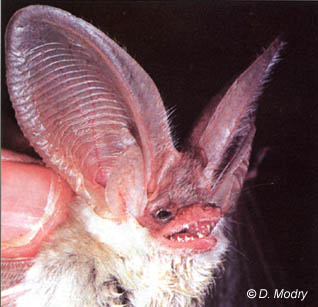
This is a medium-sized bat with a large ears (more than 35 mm) and connected across the forehead. At rest the ears are folded back, whereas the slender tragus remains erect and pointing forward. The external nares are unique in having a posterior fissure.
Range of the species is southern Europe and northern Africa south to Senegal and Ethiopia, Palestine, Arabia and south-western Asia east to Mongolia.
It is most probably occurs in all habitats in Jordan and commonly caught in mist nets. It was recorded in south Jordan near Gharandal (Wadi Araba), Disi (Wadi Rum) Qumsiyaeh et al., 1992. Ras En Naqab (Zuhair Amr collection) and the resent collection was in Wadi Rum by the RSCN fauna team (one specimen) and in Salhi'a village close to Rum ( two individuals) 1999.
This bat is found roosting caves, abandoned mines, ruins, and underground tunnels . it is usually found to be solitary and thus an estimate of its abundance is difficult.
Some of the prey of this species is gleaned from foliage, trees, rocks, cliffs and so forth. This bat is well adapted to hovering flight for a gleaning method of foraging. The long ears are held back close to body when resting. In open areas, these bats fly with the ears erect. This bat is expert climber (Qumsiyeh 1992).